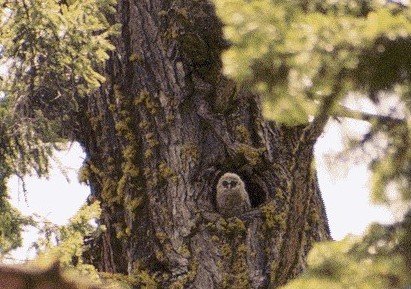Imperiled species highlight: The northern spotted owl
The Northern spotted owl (Strix occidentalis caurina ) has long been at the center of debates regarding public forest management in the Northwest because of its reliance on old-growth forest characteristics for roosting, foraging and nesting. These habitat characteristics consist of snags, coarse woody debris, and large trees with cavities. As such, the owl serves as an ‘indicator species’ for a suite of late-successional associated wildlife species that require complex mature forest habitat.
Northern spotted owls are a medium sized, brown owl with a round face that lacks ear tufts. They have concentrated circles of dark brown around each dark brown eye. Spotted owls have a yellowish green bill and their legs and feet are fully feathered.
NSO habitat range. Credit: Nk, Creative Commons.
Northern spotted owls are one of three North American spotted owl subspecies. Their distribution range stretches along the Pacific Coast region from southwest British Columbia to central California. Within this distribution range, the northern spotted owl is a non-migratory species that occupies its established home range year-round.
Each spotted owl home range is located within contiguous mature or old-growth forests that provide cover and prey. The owls generally roost in large diameter trees with multiple canopy layers that provide complex forest structure. Broken treetops, cavities, platforms abandoned by raptors and squirrels, and mistletoe brooms create preferred nesting sites. The female owl scrapes out a shallow depression in the existing debris to form the nest.
Complex canopy structure and lack of forest fragmentation also contribute to Northern spotted owls’ preferred foraging habitat. They tend to avoid recently logged or clear-cut forests and flying over brushy areas in order to avoid predation from other raptors. In southwest Oregon and northern California, northern spotted owls, a nocturnal hunter, predate mainly upon red-tree voles, red-back voles, bushy-tailed woodrats, mice, snowshoe hare, brush rabbits and pocket gophers. They are also known to opportunistically eat birds, amphibians and insects. Northern spotted owls detect their prey by site or sound, use gliding flight when approaching prey, then pounce and capture prey with their talons.
Listing: Northern spotted owls are listed as “Threatened” under the Endangered Species Act. The primary threats to the northern spotted owl are loss of habitat and habitat fragmentation due to clear-cuts or regeneration harvests and even-age forest management. Barred owl encroachment, climate change, urban and suburban expansion, water development, agricultural development, mining, and reservoir development also impact northern spotted owl habitat and populations.
Northern spotted owl juvenile at a nest.
Credit: Oregon Fish and Wildlife Service
The northern spotted owl was listed under the Endangered Species Act in 1990 and was the center of controversy in forest management in the early 1990s. The resulting Northwest Forest Plan, formalized in 1994, attempted to resolve the controversy while both providing wood products from public forest lands and protecting blocks of owl habitat. Unfortunately, the continued loss of habitat, along with unforeseen competition from barred owls, have contributed to the continued decline of Northern spotted owl populations and genetic viability.
KS Wild has worked to improve conditions for Northern spotted owls and their habitat in a number of ways. We monitor every project on approximately 8 million acres of federal lands and support efforts to restore and protect complex late-successional forest habitat while opposing agency actions that would “downgrade” or “remove” remaining owl habitat.
Our legal efforts have strengthened the federal recovery plan for the species, have protected “critical habitat” for the owl, and have contributed to the creation of fire management policies that seek to roll back the negative impacts of fire exclusion on old-growth forests in the Klamath-Siskiyous. We rely upon the best available peer-reviewed science to develop and support forest management policies that will tackle emerging threats to spotted owls from climate change and barred owl encroachment. While owl populations continue to decline, we remain steadfastly committed to finding solutions that will prevent the extinction of this iconic keystone species and the old-growth forests with which it is associated.
You can support our work to defend the remaining northern spotted owls by donating to our Wildlife Defense Fund.



